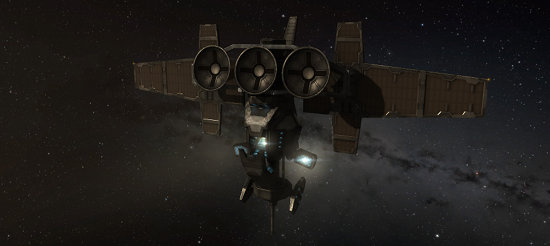Hello Capsuleers! This is CCP SoniClover fresh from my holiday hibernation to tell you all about what shenanigans Team Super Friends is up to for the Rubicon point release due at the end of January.
What you will see from us in 1.1 can be neatly divided into two parts – couple of variations of siphon units on one hand and a new deployable called Encounter Surveillance System on the other.
Put the Siphon
Let’s start with the siphon variations. There are two of them, both also small like the one released in Rubicon.
The Small Mobile ‘Rote’ Siphon Unit steals the same type of material as the base version from Rubicon. But instead of favoring raw materials over processed materials, the Rote will favor processed materials. This means it steals more of processed materials and if it can steal either raw material or simple processed materials, it will choose to steal the processed materials. As for the base version, Alchemy output is not stolen. Here are the most pertinent stats:
Processed materials siphon amount: 110 units
Raw material siphon amount: 20 units
Waste factor: 10%
Capacity: 1000
The build cost of this unit is slightly higher than for the base version.
The Small Mobile ‘Hybrid’ Siphon Unit steals polymers (from Polymer Reactor Arrays). It does not steal Fullerenes directly. The batch sizes of the polymers vary a lot (currently ranging from 2 to 1000). This huge range makes it difficult to work with. As there is really no reason for this great of a range, as part of introducing the Hybrid Siphon Unit, we’re adjusting the batch sizes for polymers a bit. More on that below, lets first look at the most pertinent stats:
Polymer siphon amount: 50% of batch size (we’re using percentages here because of the size variation differences)
Waste factor: 10%
Capacity: 1200
The build cost is the same as the base version.
A bit more on the batch sizes. We’re increasing the batch size for the smallest ones, so they all have a batch size of at least 100. We’re adjusting volume and blueprint material requirements accordingly so that the end result remains the same (i.e. each batch takes the same size as before and building requirements require the same amount of polymers proportionally). Furthermore, we will run update scripts to update all current stockpiles of polymers when the changes go live. This includes all inventories, as well as buy and sell orders and contracts. This means that players will retain the correct ratio of polymers.
Money for Pirates, ISK for Free
Now for the new deployable. The collective term is Encounter Surveillance System, or ESS. Let's start with a quick tl;dr version, refer to the rest of the text for further details. After 1.1, players receive 95% of a bounty income in Null Sec. An active ESS in a system changes the direct payout value to 80%, but further 20% is stored in a system-wide pool that can be accessed through the ESS. This additional bounty payment can rise to 25% over time. So post-1.1, players have the choice to either skip using an ESS and get 95% bounty value, or use ESS and generate 100% up to 105% of bounty value, but have a portion of it be at risk.
Each race has their own ESS, so there are four in total, Amarr/Caldari/Gallente/Minmatar Encounter Surveillance System. An ESS allows an empire to monitor bounty-generating activities in the solar system it is deployed in. Why this is a thing is due to an on-going and ever-growing feud between the empires and Concord. Concord has decided that monitoring these bounty-generating activities (i.e. killing pirates) outside of their jurisdiction is becoming too expensive, especially with the lost income from high-sec Custom Offices. As a result, they will no longer pay the full bounty amount. There is no statistical difference between the racial variants
After Rubicon 1.1 the payout for killing pirates in Null Sec is 95% of the actual bounty. So a pirate with a bounty of 100.000 ISK will give whomever killed it 95.000 ISK after the point release.
Deploying an ESS in a system affects the payout. With an active ESS, the base payout (what you get directly into your wallet) is reduced further, down to 80% of actual bounty value. This is because Concord doesn’t like it when somebody starts interfering with their bounty activity monitoring.
But what happens also is that the ESS starts computing bounty payouts. This is set to 20% of the actual bounty value. This means that with an active ESS in a system, the total bounty payouts are 100%, or equal to the value players receive today. The main difference is that part of it is only accessible through the ESS and does not go directly to the player. The ESS represents empire monitoring efforts that allow them to compensate players to offset the reduced value that Concord is paying out.
The longer an ESS is active in a system, its payout value increases over time and can rise from 20% to 25%. This addition comes on top of the other payments, i.e. the base 80% payment remains the same. This means that with a fully increased ESS, the total payment is 105% of the actual bounty value. Note that this increase only applies to bounties generated after the increase has occured. Also, the increase in payout level is based on bounty-generating activity, so the payout level will not rise for an active ESS if there is no bounties being generated in the system.
The value the ESS tracks creates a system-wide pool. This is a common pool for all bounties generated in the system, there is not a separate pool for each player.
This pool can only be accessed through the ESS. Accessing the ESS is a timed action that takes 20 seconds to complete. Only one player can access the ESS at a time and the access range is 2500 meters. Once a player has accessed the ESS, a window opens up where the player has two choices, Share and Take all. Anyone can access the ESS. The ESS cannot be accessed while cloaked.
The Share option will share the contents of the pool amongst those that have contributed to the pool. Each player then gets his own contribution back. Choosing this option is effectively confirming the monitoring efforts of the ESS as correct, allowing the empires to transfer ISK directly to the contributing players. This ISK is transferred even if the contributing player has left the system or is offline.
The Take all option will give the total contents of the pool to the player accessing the ESS. Choosing this option is effectively telling the ESS its computations are incorrect and the player will take on the responsibility of dividing the ISK correctly. At least, that’s what the empires, in their infinite wisdom, are assuming that the law-abiding pilots of New Eden will do. The ESS hands out the value of the pool in the form of ISK tags. See more below in ISK tags. It takes time for the ESS to print the tags and hand them out, this time is 40 seconds.
Here is an early version of the window:

The choice thus for players is either to skip deploying an ESS, receiving 95% of the bounty value, but getting it all directly to wallet. Or they can deploy an ESS, generating at least full bounty value and even more over time, but with a portion of the bounty value being at risk of being stolen.
Facts and Figures
Let’s try to cover some of the further aspects of the ESS in a bullet-point list (plus some repeats):
- Encounter Surveillance Systems are sold directly from the navies of the empires. For instance, the Gallente ESS is sold in Federation Navy stations. The retail price is around 30 million. Stat wise, all the ESS structures are identical. The only difference is what kind of ISK tags they drop (see more below on ISK tags).
- Only one ESS can be active in a system at any given time.
- An ESS cannot be deployed close to stations, stargates or starbases. The minimum range from these structures is several 100 kilometers.
- An ESS can only be deployed in Null Sec.
- It takes 60 seconds for a deployed ESS to become active. As with the other mobile structures, the anchoring and onlining is a single action.
- The ESS has a global beacon, meaning it will be visible by all players, allowing them to warp directly to it. Note that the new scan-block deployable does not interfer with this.
- The ESS has around 150.000 Hit Points (ca. 90000 structure, and 30000 each in armor and shield).
- The ESS can be scooped up by the owner of the ESS (the player that deployed it).
- Destroying or scooping the ESS will not affect the system-wide pool. That is only affected by successfully accessing the ESS and choosing to Share or Take all. The system wide-pool stays intact and becomes available again when another ESS is deployed.
- The payout level of an ESS is reset if it is destroyed, scooped or when it is accessed and the system-wide pool is distributed.
- The current payout level of the ESS is visible in the name of it, and can thus be seen anywhere in the system.
- The ESS has a warp bubble with a radius of 15km. Warping to the ESS brings you to the edge of the bubble. This warp bubble has exactly the same functionality as a normal one.
- Whenever a ship warps to the ESS, a broadcast is made in local informing everyone in the system that player X is in the vicinity of the ESS. This triggeres even if the approaching ship is cloaked.
- Anyone can access an ESS, not just the owner.
- When a player accessing an ESS has chosen whether to Share or Take all, everyone that contributed to the pool receive a notification of the choice made. This notification includes the name of the player that accessed it.
The Bounty Reimbursement Tags
When a player chooses the Take all option when accessing an ESS, that player receives the ISK in the pool in the form of tags. These tags are called Bounty Reimbursement Tags. Each empire have their own tags and the tags dropped depend on the ESS type (so the Amarr ESS will drop Amarr tags). The Bounty Reimbursement Tags have a volume of 0.01. The actual functionality is that the ESS stores blank tags and then prints tags and drops them when needed.
Apart from the empire distinction, tags also come in four value variations, 10.000, 100.000, 1 million and 10 million. So the tags for Amarr, for example, are named Amarr 10K Bounty Reimbursement Tag, Amarr 100K Bounty Reimbursement Tag, Amarr 1M Bounty Reimbursement Tag and Amarr 10M Bounty Reimbursement Tag.
When the Take all option is selected, the pool is divided into tags, using as few tags as possible. Remnants (i.e. whatever is left under 10K) are removed.
This is the End
You can test the new siphon units and the ESS feature on SISI right now, we’d love for as many as possible to try them out and give us feedback.
That’s it for Team Super Friends. Our main goal for Rubicon and its point release has been to introduce different ways for players to affect each other’s gameplay, introducing risk where there was none before, give players some interesting choices and general mayhem. We hope we’ve hit at least some of our goals, improving EVE in the process. Until next time.
New to EVE? Start your 14-day free trial today.
Returning pilot? Visit Account Management for the latest offers and promotions


